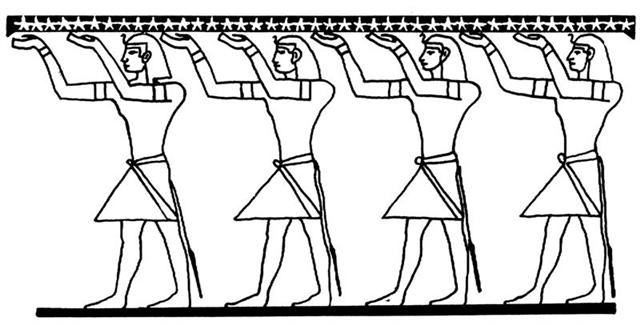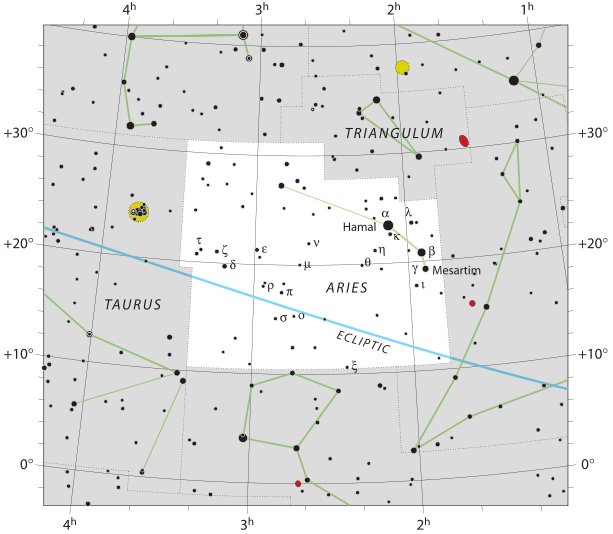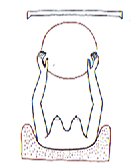Could the creators of
the C and G texts have tried to put
some order in the apparent mess caused by
the Gregorian 'crooked canoe'? The
time was ripe, because there were 4
precessional days down to the time
of the 13th Gregory. And 4 * 71 = *284
(December 30) = day 364 = 4 * 91.
... Gregory dropped 10 days to bring the
calendar back into synchronisation with the seasons.
Accordingly, when the new calendar was put in use, the error
accumulated in the 13 centuries since the Council of Nicaea
was corrected by a deletion of ten days. The Julian calendar
day Thursday, 4 October 1582 was followed by the first day
of the Gregorian calendar, Friday, 15 October 1582 (the
cycle of weekdays was not affected) ...
... The reform was adopted initially by the
Catholic countries of Europe. Protestants and Eastern
Orthodox countries continued to use the traditional Julian
calendar and adopted the Gregorian reform after a time, for
the sake of convenience in international trade. The last
European country to adopt the reform was Greece, as late as
1923 ... Britain and the British Empire (including the
eastern part of what is now the United States) adopted the
Gregorian calendar in 1752, by which time it was necessary
to correct by 11 days. Wednesday, 2 September 1752, was
followed by Thursday, 14 September 1752. Claims that rioters
demanded 'Give us our eleven days' grew out of a
misinterpretation of a painting by William Hogarth:
However, a picture will tell more than simple words,
will be
possible to understand on several levels.
The transition period between the hairy back
of the head of Ku and his alighted face needed only 4 right
ascension days, and 4
calendar days was also the difference between 52 weeks (= 4 * 91
days) and 360 days.

|
BABYLONIAN ECLIPTIC CONSTELLATIONS: |
|
26 |
Mahar sha hi-na Shahū |
Western One in the Tail of the Goat |
γ (Nashira)
Capricorni |
328.0 |
Febr 12 (43) |
|
27 |
Arkat sha hi-na Shahū |
Eastern One in the Tail of the Goat |
δ (Deneb Algiedi)
Capricorni |
329.8 |
Febr 13 (44) |
|
|
|
0 |
1-iku |
Field measure |
τ
(Anunitum)
Piscium |
16.5 |
April 6 (96) |
|
|
|
1 |
Mahrū-sha-rishu-ku |
Front of the Head of Ku |
β (Sheratan),
γ (Mesarthim) Arietis |
27.4 |
April 17 (107) |
|
2 |
Arku-sha-rishu-ku |
Back of the Head of Ku |
α (Hamal)
Arietis |
30.5 |
April 20 (110) |
|
|
|
3 |
Temennu |
Foundation Stone |
η (Alcyone)
Tauri |
56.1 |
May 16 (136) |
|
4 |
Pidnu-sha-Shame |
Furrow of Heaven |
α (Aldebaran)
Tauri |
68.2 |
May 28 (148) |
|
5 |
Shur-narkabti-sha-iltanu |
Star in the Bull towards the north |
β (El Nath)
Tauri |
80.9 |
June 9 (160) |
|
6 |
Shur-narkabti-sha-shūtū |
Star in the Bull towards the south |
ζ (Heavenly Gate)
Tauri |
84.0 |
June 13 (164 |
Strangely the front of the head of the god (Ku)
- at Sheratan (β, female sign)
- came before α (Hamal). A woman should always go a few
paces behind her man.
But if there were 4 days from the
December solstice to Christmas Eve and 4 days from the June
solstice to St John's Day, then there surely ought to be 4 days
also from an equinox to its corresponding cardinal calendar
day:
The central Rakau element was
standing there also at the equinoxes, although at another
time angle in the night. And to the left of Rakau there
was a more profound Mother Earth (as a Turtle) glyph. The Rakau
(the α male) was surrounded by
10 'feathers' (supporters) and separated from the Nativity
place (central ceremonial ground) by 4
days (2 down and 2 up), and we could think 21 + 4 = 25 (Christmas Eve, Julian
spring equinox, etc).
The front of the
head, his Face (Mata), ought to mean the
place where light returned. But this could not be
observed until at least 16 days after Sun had
been there. Counting feathers we
will find 5 + (2 + 2) + 4 = 7 + 6 =
13. And then we could add the 3
basic elements of the glyph and get 16:
 |
 |
 |
|
Cb1-1
(393) |
Cb1-2 |
Cb1-3 |
|
E tupu - ki roto |
o
te hau tea |
|
April 17
(107) |
18 |
19 |
|
'March
21 (80) |
22 |
23 |
|
Al
Sharatain-1 /
Ashvini-1 /
Bond-16
Segin, Mesarthim, ψ
Phoenicis (27.2),
SHERATAN,
φ Phoenicis (27.4) |
ι Arietis (28.0), λ
Arietis (28.2) |
ALRISHA,
χ Phoenicis (29.2), Alamak (29.7) |
|
Muphrid
(210.1), ζ Centauri (210.3) |
φ
Centauri (211.0), υ¹ Centauri (211.1), υ² Centauri
(211.8), τ Virginis (211.9) |
Agena
(212.1), θ Apodis (212.5),
THUBAN
(212.8) |
|
October
17 (290) |
18 |
19 |
|
'September 20 |
21 |
22 (265) |
 |
|
Cb1-4 (396) |
| ki te henua -
te maro |
|
April 20
(*30) |
|
'March
24 (*3) |
|
2h
(30.4) κ
Arietis (30.3),
HAMAL
(30.5)
Alkes
|
|
14h
(213.1)
χ Centauri (213.0), Menkent
(213.1) |
|
October
20 (293) |
|
'September 23 (266) |
 |
 |
 |
rutua - te pahu - rutua te maeva -
atua rerorero - atua hiko ura - hiko o tea - ka higa
te ao ko te henua ra ma te hoi atua |
|
Cb1-5 |
Cb1-6
(398) |
Cb1-7 |
|
April 21
(111) |
22 (*32
= *398 - 366) |
23 (*399
= *33 + 366) |
|
'March 25 (84) |
26 |
27 (*372
= *6 + 366) |
|
η Arietis (31.9) |
no star listed (32) |
θ Arietis (33.3),
MIRA
(33.7) |
|
Neck-2
Asellus Tertius,
κ VIRGINIS,
14 Bootis (214.8) |
Al
Ghafr-13 /
Svāti-15
TAHUA-TAATA-METUA-TE-TUPU-MAVAE
15
Bootis (215.2),
ARCTURUS
(215.4), Asellus Secundus (215.5),
Syrma, λ Bootis (215.6), η Apodis (215.8) |
ι Lupi,
18 Bootis (216.3), Khambalia (216.4), υ Virginis
(216.5), ψ Centauri (216.6), ε Apodis (216.8) |
|
October
21 (*214) |
22 (295) |
23 |
|
'September 24 (*187) |
25 (268) |
26 |
| |
 |
 |
 |
 |
|
Cb1-8
(400) |
Cb1-9 |
Cb1-10 |
Cb1-11 (403) |
|
April 24
(*400) |
25 |
26 (116) |
27 |
|
'March
28 |
29 |
30 |
31 (90) |
|
no star listed (34) |
ξ Arietis (35.0) |
no star listed (36) |
no star listed (37) |
|
Asellus
Primus (217.8) |
τ Lupi
(218.1), φ Virginis (218.7)
Fomalhaut
|
σ Lupi
(219.1), ρ Bootis (219.5), Haris (219.7) |
σ Bootis
(220.2), η Centauri (220.4) |
|
October
24 |
25 |
26 |
27 (300) |
|
'September 27 |
28 |
29 |
30 (273) |
 |
 |
 |
|
Cb1-12 |
Cb1-13
(405) |
Cb1-14 |
|
manu rere - kua rere ga manu - ki te ragi |
eaha te nuku erua |
koia kua huki |
|
April 28
(118) |
29 |
30 (*40) |
|
'April 1
(91) |
2 |
3 (*13) |
|
ν Arietis (38.5) |
μ Arietis (39.4), Head
of the Fly (39.6), Kaffaljidhma (39.8) |
ο Arietis (40.0),
Angetenar (40.2), Right Wing (40.9) |
|
ρ Lupi
(221.0),
TOLIMAN
(221.2), π Bootis (221.8), ζ Bootis (221.9) |
31
Bootis (222.0), Yang Mun (222.1), Rijl al Awwa
(222.5), ο Bootis (222.9) |
Izar
(223.0), 109 Virginis, α Apodis (223.3) |
|
October
28 (301) |
29
(*222) |
30 |
|
'October
1 (274) |
2 (*195) |
3 |
 |
 |
 |
|
Cb1-15 |
Cb1-16 (408) |
Cb1-17 |
|
e niu tu |
ki te ariki - e ka hua ra tona rima |
koia kua iri i ruga o te rima - e o to vaha
mea |
|
May
1 (121) |
2 |
3 |
|
'April 4 (460) |
5 |
6
(96) |
|
Bharani-2 /
Stomach-17
π Arietis (41.2),
BHARANI
(41.4), τ² Eridan, σ Arietis (41.7) |
no star listed (42) |
ρ
Arietis (43.0), Acamar (43.6), ε Arietis (43.7)
Denebola
|
|
Al Zubānā-14a /
Visakha-16 /
Root-3
ZUBEN ELGENUBI
(224.2), ξ Bootis, ο Lupi (224.5) |
Kochab (225.0) |
Ke Kwan (226.3), Ke
Kwan (226.4), Zuben Elakribi (226.8) |
|
October 31 (304) |
November 1 |
2 |
|
'October 4 (277) |
5 |
6 |

|
O
Ó;
1. Prepositon marking the genitive. 2.
Preposition expressing the cause, the reason:
because of (also i): e-tahataha-á te
vaka o te tokerau. the boat rocks from side
to side because of the wind. 3. Lest, in order
not to... e-ûi koe o higa, be careful not
to fall. 4. Sometimes used as conditional: if,
whether; ina kai agiagi au o tu'u-mai te
Matu'a, I don't know if the Padre has
arrived. 5. Article sometimes used preceding
proper names; ó Hotu Matu'a, ó Santiago.
6. To answer saying 'oh'; ana ragi te tagata
ki te rua tagata, 'hé koe?', he-ó-mai, he-kî:
'ó, î au', when a man calls another, asking
'where are you?' (the other) answers saying 'oh,
I am here'. O; to celebrate a festival:
he-o i te gogoro. Vanaga.
1. Tai o, rippling
water. (Compare in some sea sense - Mgv.:
akao, a narrow arm of the sea, to throw
stones into the water in order to drive fish
into a net.) 2. Of. Mgv., Mq., Ta.: o,
of. 3. A verb sign; o mua, at first;
ina o nei, to be away (not-being-here).
Churchill. |

|
















